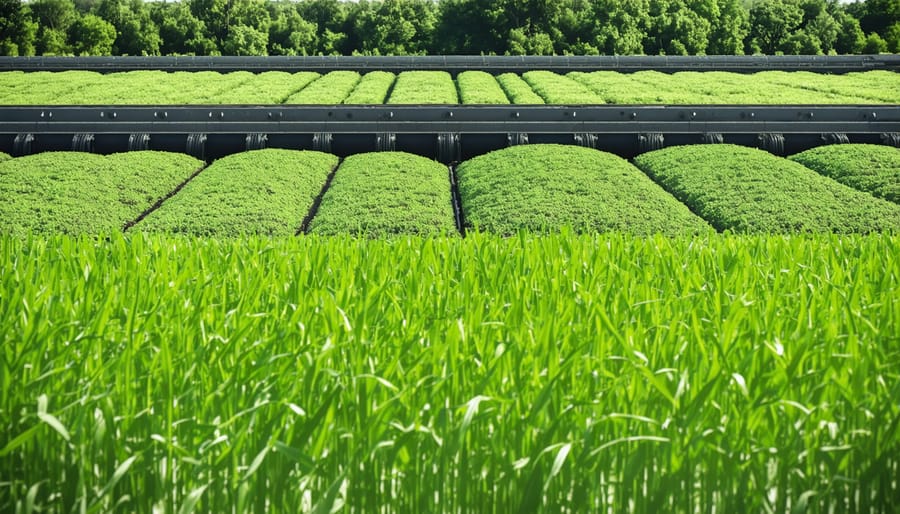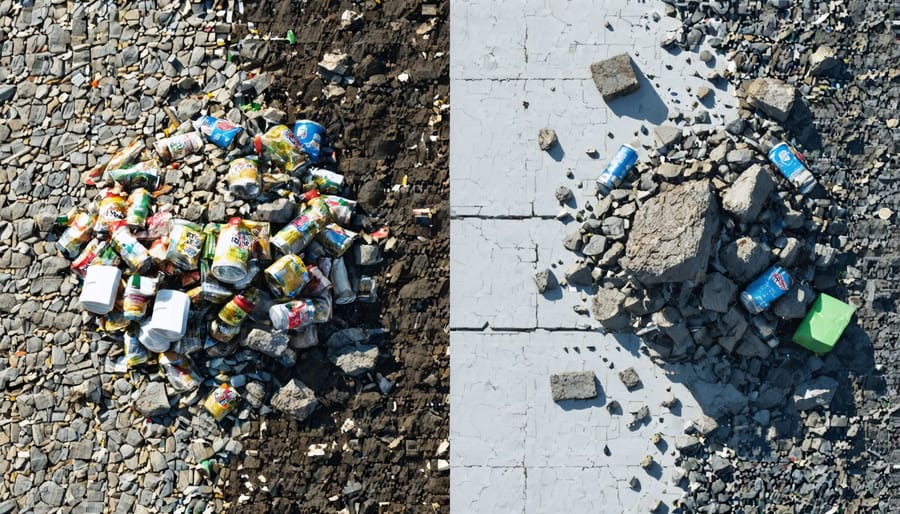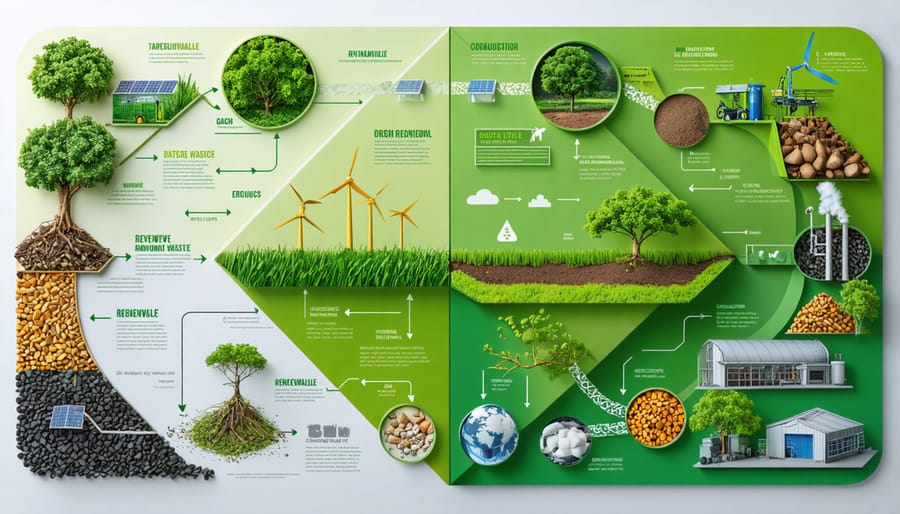In the heart of our global waste crisis lies a revolutionary solution: waste circularity. This transformative approach reimagines our traditional ‘take-make-dispose’ model, turning waste streams into valuable resources that fuel economic growth while protecting our environment. Across Australia, innovative companies are already proving that one industry’s waste can become another’s treasure – from converting agricultural residues into renewable energy to transforming construction debris into new building materials.
The circular economy isn’t just an environmental imperative; it’s a $4.5 trillion economic opportunity that’s reshaping how businesses operate. By closing the loop on waste, organizations are discovering new revenue streams, reducing operational costs, and building resilience against resource scarcity. From Sydney’s urban centers to regional farming communities, waste circularity is creating jobs, driving innovation, and helping Australia transition toward a more sustainable future.
As climate change intensifies and landfills reach capacity, waste circularity offers a practical pathway forward. This article explores how Australian businesses and communities are embracing circular principles, the technologies making it possible, and the remarkable success stories emerging from this waste-to-wealth revolution.
Waste Circularity: The New Business Frontier
Beyond Recycling: The Circular Economy Revolution
While recycling has been our go-to solution for waste management, the circular economy takes this concept several steps further. Instead of the traditional ‘take-make-dispose’ model, waste circularity reimagines our entire approach to resources and waste. Think of it as nature’s own system – where nothing truly goes to waste, and everything serves a purpose.
Unlike conventional recycling, which often downgrades materials over time, circular economy principles focus on designing out waste from the start. This means creating products that can be easily dismantled, repaired, and repurposed, maintaining their value throughout multiple lifecycles. In Australia, innovative companies are already embracing this approach, from furniture manufacturers using reclaimed timber to fashion brands creating garments from recycled plastics.
The circular economy also emphasises sharing, leasing, and reusing products rather than simply recycling them at the end of their life. For instance, many Australian businesses now offer product-as-service models, where customers lease items instead of buying them outright. This shift not only reduces waste but creates new business opportunities and jobs in maintenance, repair, and remanufacturing sectors.
This revolutionary approach is helping us move beyond the limitations of traditional recycling towards a truly sustainable future.

The Business Case for Waste-to-Resource
Transforming waste into valuable resources isn’t just environmentally sound – it’s becoming increasingly profitable for Australian businesses. Companies embracing waste circularity are discovering significant cost savings through reduced waste disposal fees and the creation of new revenue streams from previously discarded materials.
For instance, several Australian food manufacturers are now converting organic waste into biogas, simultaneously reducing their energy costs and waste management expenses. These initiatives typically see a return on investment within 3-5 years, with some businesses reporting annual savings of up to $500,000 in energy costs alone.
The circular economy also creates new market opportunities. Waste management companies are evolving into resource recovery specialists, offering innovative solutions and creating jobs in emerging sectors. According to industry forecasts, Australia’s waste-to-resource market could generate over $2 billion in economic benefits by 2025.
Beyond direct financial gains, businesses adopting circular practices often enjoy enhanced brand reputation, increased customer loyalty, and improved stakeholder relationships. This competitive advantage becomes increasingly valuable as consumers and investors prioritise environmentally responsible companies.
Transforming Agricultural Waste into Value

From Farm Waste to Energy Gold
In the sun-scorched paddocks of regional Australia, what many see as agricultural waste is rapidly transforming into a valuable energy resource. From sugar cane residue to wheat stubble, farmers are discovering that yesterday’s farm waste can power tomorrow’s communities. This innovative approach to waste management is revolutionizing how we think about renewable energy solutions while creating new income streams for agricultural communities.
Take the pioneering efforts in Queensland’s sugar belt, where bagasse – the fibrous matter left after crushing sugarcane – now powers entire communities. Local mills have installed bioenergy systems that convert this waste into electricity, helping reduce landfill while providing clean energy to thousands of homes.
In Victoria’s wheat belt, innovative farmers are collecting crop stubble that once would have been burned in the field. Through advanced anaerobic digestion processes, this agricultural by-product is transformed into biogas, creating a sustainable energy source while improving soil health by reducing open burning practices.
The benefits extend beyond energy production. This circular approach helps farmers minimize waste disposal costs, reduces greenhouse gas emissions, and creates valuable by-products like nutrient-rich biochar that can be returned to the soil. It’s a win-win situation that demonstrates how smart waste management can transform agricultural challenges into opportunities for a more sustainable future.
Creating Valuable By-products
Agricultural waste transformation is revolutionising resource efficiency across Australia, creating valuable products that benefit multiple industries. For instance, sugarcane bagasse, traditionally seen as a burden for sugar mills, is now being converted into sustainable packaging materials, replacing single-use plastics in many applications.
In the wine industry, grape pomace is finding new life as a source of antioxidants and natural food colorants. These compounds are increasingly sought after by the cosmetics and food industries, creating additional revenue streams for wineries while reducing waste. Similarly, spent coffee grounds from cafes are being repurposed into biodegradable plant pots and organic fertilizers, supporting urban gardening initiatives.
One of the most innovative developments is the transformation of nutshells and fruit stones into activated carbon, which is used in water filtration systems and air purification technologies. In Western Australia, macadamia nut processors are leading this charge, turning their waste into high-value carbon products.
Rice hulls, abundant in New South Wales farming regions, are being converted into silica for use in construction materials and electronics manufacturing. This not only creates a new income source for farmers but also reduces the environmental impact of rice production.
These transformations demonstrate how agricultural waste can become valuable resources, supporting both environmental sustainability and economic growth in regional communities.
Industrial Waste Recovery Technologies
Advanced Sorting and Processing
Modern waste sorting facilities have revolutionized how we process and recover valuable materials from waste streams. Using advanced optical sorting technology, automated systems can now identify and separate different types of plastics, metals, and other materials with remarkable precision. In Australia, facilities like the Advanced Resource Recovery Centre in Melbourne employ artificial intelligence and robotics to sort through mixed recyclables at speeds of up to 12,000 items per hour.
These cutting-edge facilities utilize various technologies including near-infrared sensors, which identify different polymer types, and eddy current separators that extract non-ferrous metals. X-ray transmission technology helps separate materials based on their atomic density, while advanced air classification systems sort materials by weight and size.
One notable innovation is the development of smart waste bins equipped with sensors that monitor fill levels and automatically compress waste to optimize collection efficiency. These bins are already being trialled in several Australian cities, reducing collection frequencies by up to 80%.
Biological processing has also seen significant advances, with automated sorting systems now able to separate organic waste for composting or anaerobic digestion. Modern composting facilities use sophisticated monitoring systems to maintain optimal conditions, while anaerobic digesters employ advanced biogas capture technology to maximize energy recovery.
These technological advances not only improve recovery rates but also create higher quality recyclable materials, making circular economy initiatives more viable and profitable.
Energy Recovery Systems
Energy recovery systems represent a crucial link in the waste circularity chain, transforming what was once considered unusable waste into valuable energy resources. These innovative technologies are revolutionizing sustainable power generation across Australia, offering both environmental and economic benefits.
The most common energy recovery methods include anaerobic digestion, which converts organic waste into biogas, and thermal treatment processes like gasification and pyrolysis. In rural Australia, farm waste-to-energy systems are gaining traction, with several facilities now converting agricultural residues into electricity and heat for local communities.
Advanced thermal treatment facilities are particularly effective at handling non-recyclable waste streams, producing syngas that can be used for electricity generation or converted into transport fuels. These systems typically achieve energy conversion efficiencies of up to 80%, significantly reducing landfill dependency while creating renewable energy.
Modern energy recovery facilities also incorporate sophisticated emissions control systems, ensuring minimal environmental impact. For instance, the Eastern Creek facility in Western Sydney demonstrates how urban waste can be safely converted into power for thousands of homes while meeting strict environmental standards.
The integration of these systems into existing waste management infrastructure is creating new opportunities for councils and businesses to reduce their carbon footprint while generating valuable energy resources, making them an essential component of Australia’s circular economy future.
Success Stories: Australian Circular Economy Champions

Regional Success Stories
In the heart of South Australia, the Barossa Valley Cooperative has transformed wine production waste into a thriving circular economy model. By converting grape marc into agricultural compost and grape seed oil, they’ve created new revenue streams while eliminating waste. Their success has inspired neighbouring vineyards to adopt similar practices, creating a regional network of sustainable waste management.
Moving north to Queensland, the Bundaberg Sugar Mill exemplifies how agricultural waste can power decentralized energy systems. Their bagasse-to-energy program not only powers their operations but also supplies renewable electricity to local communities, demonstrating the perfect synergy between waste reduction and energy production.
In Western Sydney, EcoHub Industries has pioneered a revolutionary textile recycling program. Working with local fashion retailers, they’ve established a collection system that processes old clothing into new fabric, reducing landfill waste while creating jobs. Their innovation has caught the attention of major clothing brands, leading to partnerships that are scaling up the initiative nationwide.
Perhaps most impressive is the Central Coast Council’s food waste initiative. By partnering with local restaurants and supermarkets, they’ve created a comprehensive organic waste collection system that produces high-quality compost for urban farming projects. This program has reduced municipal waste by 40% while supporting local food production, creating a truly circular system that benefits the entire community.
These success stories showcase how Australian businesses are turning waste challenges into opportunities, proving that circular economy principles can deliver both environmental and economic benefits while strengthening local communities.
Measuring Impact and Returns
The impact of waste circularity initiatives in Australia has shown remarkable returns, both environmentally and economically. Recent studies indicate that businesses implementing circular practices have reduced their waste disposal costs by an average of 30% while creating new revenue streams from previously discarded materials.
A standout example is the Western Sydney Food Processing Hub, which transformed its waste management approach to achieve zero waste to landfill within two years. By integrating with modern energy infrastructure, they converted food waste into biogas, generating enough power to meet 40% of their energy needs.
The measurable benefits extend beyond direct cost savings. Companies report enhanced brand reputation, with 65% of Australian consumers showing increased loyalty to brands demonstrating circular practices. Employment opportunities in the circular economy sector have grown by 25% since 2019, creating new roles in resource recovery, remanufacturing, and sustainable design.
In the agricultural sector, circular initiatives have reduced chemical fertilizer use by up to 40% through composting and nutrient recovery systems. This has resulted in improved soil health and reduced environmental impact while maintaining crop yields.
The return on investment for circular initiatives typically ranges from 18 months to three years, with some projects showing faster payback periods. For example, a Melbourne-based manufacturer invested $500,000 in circular systems and recovered their costs within 14 months through reduced waste management fees and material savings.
These outcomes demonstrate that waste circularity isn’t just environmentally responsible – it’s a smart business decision that delivers tangible returns across multiple metrics.
The journey towards waste circularity represents a fundamental shift in how we view and manage resources in Australia and globally. By embracing circular principles, we’re not just reducing waste – we’re creating new opportunities for economic growth, environmental protection, and social development.
The success stories we’ve explored demonstrate that waste circularity is not just a theoretical concept but a practical reality delivering tangible benefits. From agricultural waste transformation to innovative industrial symbiosis projects, Australian businesses and communities are leading the way in circular economy initiatives.
Looking ahead, the future of waste circularity appears promising. Technological advancements continue to unlock new possibilities for resource recovery and reuse. The growing commitment from government bodies, industry leaders, and communities provides a strong foundation for expanding circular practices across all sectors.
However, realizing the full potential of waste circularity requires ongoing collaboration and innovation. By continuing to invest in research, infrastructure, and education, we can accelerate the transition to a truly circular economy. Every individual, business, and organization has a role to play in this transformation.
As we move forward, the focus must remain on practical, scalable solutions that create value while preserving our natural resources. The circular economy journey may be challenging, but the rewards – both environmental and economic – make it an essential path for Australia’s sustainable future.

